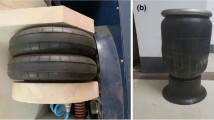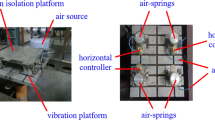Abstract
In this paper, a novel low frequency isolation model (LFIM) which is built by integrating the wedge-roller-spring and cam-roller-spring mechanism is proposed. Due to the stiffness opposite of two mechanisms, the LFIM can obtain the low dynamic stiffness, meaning that the system can obtain the desirable low resonant frequency. Instead of using mechanical spring, in this study, the pneumatic cylinder with auxiliary chamber is considered as the air spring, thereby, the dynamic stiffness of the proposed system can be easily adjusted as well as controlled to obtain the design equilibrium position and low stiffness at this position as the weight of the isolated load is changed. Furthermore, the proposed model can convert easily the passive model into semi-active one. By analysis solution, the pressure change process in air spring is obtained, a virtual model of the air spring is then built through Amesim software to verify the pressure mode in the air spring. Next, analyzing the effects of the basic working parameters on the dynamic stiffness of LFIM is realized. Based on the analysis solution, the design procedure for LFIM to obtain the high static low dynamic stiffness characteristic is suggested. Finally, the stability of the equilibrium positions is also investigated. This study result provides a useful solution for designing and analyzing dynamic response of LFIM.
























Similar content being viewed by others
Abbreviations
- A :
-
Effective area of piston
- C p :
-
Specific heat capacity at constant pressure
- Cv :
-
Specific heat capacity at constant volume
- E :
-
Energy
- F :
-
Force
- G :
-
Mass flow rate
- H o :
-
Static vertical deformation of the LFIM
- h :
-
Length of the piston stroke
- M :
-
Mass
- n :
-
Polytropic index of compression
- P :
-
Pressure
- r :
-
Radius of roller
- R :
-
Radius of semicircular cam
- T :
-
Temperature
- u :
-
Relative displacement
- V :
-
Volume
- x :
-
Horizontal displacement
- y :
-
Absolute vertical displacement
- α :
-
Inclined angle of wedge
- μ :
-
Pressure ratio
References
Alabuzhev, A., Critchin, A., Kim, L., Migirenko, K., Chon, V., & Stepanov, P. (1989). Vibration protecting and measurement with quasi-zeo stiffness. New York: Taylor & Francis Group.
Carrella, A., Brennan, M. J., Waters, T. P., & Lopes, V., Jr. (2012). Force and displacement transmissibility of a nonlinear isolator with high-static-low-dynamic-stiffness. International Journal of Mechanical Sciences,55, 22–29.
Carrella, A., Brennan, M. J., & Waters, T. P. (2008). Demonstrator to show the effects of negative stiffness on the natural frequency of a simple oscillator. Proceedings of Mechanical Engineers Part C: Journal of Mechanical Engineering Science,222, 1189–1192.
Brennan, M. J., Kovacic, I., Carrella, A., & Waters, T. P. (2008). On the jump-up and jump-down frequencies of the Duffing oscillator. Journal of Sound and Vibration,318, 1250–1261.
Kovacic, I., Brennan, M. J., & Lineton, B. (2009). Effects of a static force on dynamic behavior of a harmonically excited quasi-zero stiffness system. Journal of Sound and Vibration,325, 870–883.
Cao, Q. I., Wiercigroch, M., Pavlovskaia, E. E., Crebogi, C., & Thompson, J. M. T. (2006). Archetypal oscillator for smooth and discontinuous dynamics. Physical Review E,74, 046218.
Cao, Q. I., Wiercigroch, M., Pavlovskaia, E. E., Crebogi, C., & Thompson, J. M. T. (2008). The limit case response of the archetypal oscillator for smooth and discontinuous dynamic. International Journal of Non-Linear Mechanics,43, 462–473.
Tian, R., Cao, Q., & Yang, Q. (2010). The codimension-two bifurcation for the recent proposed SD oscillator. Nonlinear Dynamic,59, 19–27.
Hao, Z., & Cao, Q. (2014). A novel dynamical model for GVT nonlinear supporting system with stable-quasi-zero-stiffness. Journal of Theoretical and Applied Mechanics,52, 199–213.
Shaw, A. D., Neild, S. A., Wagg, D. J., Weaver, P. M., & Carrella, A. (2013). A nonlinear spring mechanism incorporating a bistable composite plate for vibration isolation. Journal of Sound and Vibration,332, 6265–6275.
Shaw, A. D., Neild, S. A., & Wagg, D. J. (2014). Dynamic analysis of high static low dynamic stiffness vibration isolation mounts. Journal of Sound and Vibration,332, 1437–1455.
Xu, J., & Sun, X. (2015). A multi-directional vibration isolator based on Quasi-Zero-Stiffness structure and time-delayed active control. International Journal of Mechanical Science,100, 126–135.
Le, T. D., & Ahn, K. K. (2011). A vibration isolation system in low frequency excitation region using negative stiffness structure for vehicle seat. Journal of Sound and Vibration,330, 6311–6335.
Le, T. D., & Ahn, K. K. (2013). Experimental investigation of a vibration isolation system using negative stiffness structure. Journal of Mechanical Sciences,70, 99–112.
Le, T. D., & Nguyen, T. P. (2017). Dynamic simulation of seat suspension system with virtual prototyping technology. Journal of Advanced Mechanical Design, System, and Manufacturing,11, 1–11.
Dong, G., Zhang, X., Luo, Y., Zhang, Y., & Xie, S. (2018). Analytical study of the low frequency multi-direction isolator with high-static-low-dynamic stiffness struts and spatial pendulum. Mechanical Systems and Signal Processing,110, 521–539.
Wang, X., Liu, H., Chen, Y., & Gao, P. (2018). Beneficial stiffness design of a high-static-low-dynamic-stiffness vibration isolator based on static and dynamic analysis. International Journal of Mechanical Sciences,142–143, 235–244.
Hu, Z., Wang, X., Yao, H., Wang, G., & Zheng, G. (2018). Theoretical analysis and experimental identification of a vibration isolator with widely-variable stiffness. Journal of Vibration and Acoustics,140, 051014.
Sun, M., Song, G., Li, Y., & Huang, Z. (2019). Effect of negative stiffness mechanism in a vibration isolator with asymmetric and high-static-low-dynamic stiffness. Mechanical Systems and Signal Processing,124, 388–407.
Carrella, A., Brennan, M. J., Waters, T. P., & Shin, K. (2008). On the design of a high-static-low-dynamic stiffness isolator using linear mechanical springs and magnets. Journal of Sound and Vibration,315, 712–720.
Li, Q., Zhu, S., Hu, J., Min, Q., & Pang, L. (2013). A negative stiffness vibration isolator using magnetic spring combined with rubber membrane. Journal of Mechanical Science and Technology,27, 813–824.
Zheng, Y., Zhang, X., Luo, Y., Yan, B., & Ma, C. (2016). Design and experiment of a high-static-low-dynamic stiffness isolator using a negative stiffness magnetic spring. Journal of Sound and Vibration,360, 31–52.
Zheng, Y., Li, Q., Bo, Y., Luo, Y., & Zhang, X. (2018). A stewart isolator with high-static-low-dynamic stiffness struts based on negative stiffness magnetic spring. Journal of Sound and Vibration,422, 390–408.
Zhang, F., Shao, S., Tian, Z., Xu, M., & Xie, S. (2019). Active-passive hybrid vibration isolation with magnetic negative stiffness isolator based on Maxwell normal stress. Mechanical system and Signal Processing,123, 244–263.
Le, T. D. (2017). Nguyen VAD low frequency vibration isolator with adjustable configurative parameter. International Journal of Mechanical Science,134, 224–233.
Acknowledgements
This research is funded by Vietnam National Foundation for Science and Technology Development (NAFOSTED) under Grant number 107.04-2016.35.
Author information
Authors and Affiliations
Corresponding author
Additional information
Publisher's Note
Springer Nature remains neutral with regard to jurisdictional claims in published maps and institutional affiliations.
This paper was presented at PRESM2019.
Rights and permissions
About this article
Cite this article
Vo, N.Y.P., Le, T.D. Static Analysis of Low Frequency Isolation Model Using Pneumatic Cylinder with Auxiliary Chamber. Int. J. Precis. Eng. Manuf. 21, 681–697 (2020). https://doi.org/10.1007/s12541-019-00301-y
Received:
Revised:
Accepted:
Published:
Issue Date:
DOI: https://doi.org/10.1007/s12541-019-00301-y




